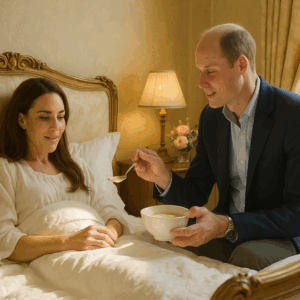
Beneath the shimmering arches of Windsor Castle, where history’s echoes linger in every stone, two visions of grace and legacy converged on October 15, 2025, in a moment that felt pulled straight from a fairy tale. Princess Catherine, the poised future Queen of England, and Princess Rajwa Al Hussein, Jordan’s emerging icon of modern royalty, shared their inaugural private conversation—a first in the annals of intertwined thrones. As the world held its breath, these two women, guardians of ancient lineages and beacons of contemporary poise, bridged cultures in a dialogue that symbolized unity amid global flux. It wasn’t just a meeting; it was a milestone, a subtle yet seismic shift in royal diplomacy.
The encounter unfolded during Crown Prince Hussein’s official state visit to the UK, his second rendezvous with Prince William this year alone. Accompanied by his wife, Princess Rajwa—whose 2023 wedding in Amman had already drawn the Waleses across continents—the Jordanian royals were welcomed into Windsor’s hallowed White Drawing Room. This opulent space, witness to coronations and quiet confidences, set the stage for an audience that blended personal warmth with diplomatic finesse. Kensington Palace’s official footage captured the magic: the four royals posing in harmonious smiles, then the princesses descending a grand staircase, deep in animated exchange. Catherine, radiant in a tailored khaki Roland Mouret suit cinched with a white blouse, exuded effortless elegance. Rajwa, channeling subtle homage, mirrored the sophistication in an Alexander McQueen black wool jumpsuit layered over an Alaïa white shirt, accented by bold red Gianvito Rossi pumps—a nod, perhaps, to her hostess’s storied style.
This wasn’t mere pageantry. Catherine’s childhood ties to Jordan, forged during her family’s expatriate years in Amman, lent the gathering an intimate layer. The princesses’ chat, though shielded from public ears, reportedly touched on shared passions: mental health advocacy, sustainable fashion, and the quiet challenges of royal motherhood.

Just days prior, Rajwa had joined Princess Eugenie in South West London to spotlight mental health initiatives at Springfield University Hospital and St George’s NHS Trust, touring art installations designed to soothe young minds—a cause echoing Catherine’s own trailblazing work with children’s welfare. Their dialogue, Kensington Palace hinted, delved into these synergies, fostering potential collaborations that could amplify global voices for vulnerable youth.
Meanwhile, the princes forged their own bond. William and Hussein, both alumni of elite helicopter pilot training—William via the RAF Search and Rescue, Hussein through Jordan’s air force—embarked on a joint outing to RAF Benson in Oxfordshire. There, amid the thrum of Chinook rotors and the precision of operational squadrons, they discussed aviation tactics, defense partnerships, and emergency response innovations. Hussein’s Instagram post encapsulated the day’s spirit: “It was a pleasure for Rajwa and myself to meet Their Royal Highnesses… and an honour to join His Royal Highness on a visit to RAF Benson.” The visit underscored enduring UK-Jordan alliances, from counter-terrorism pacts to regional stability efforts in the Middle East.
Yet, this Windsor whisper carried broader ripples. In an era of fractured geopolitics, the image of these future queens—Catherine, 43, a symbol of resilient British tradition; Rajwa, 31, a fusion of Saudi heritage and Jordanian progress—chatting freely evoked hope. Rajwa’s European tour, spanning Paris audiences with Macron to this English idyll, marked her evolution from private citizen to public pillar, her poise drawing inevitable parallels to Catherine’s own ascent. Fashion watchers buzzed over their coordinated chic: both favoring sustainable British labels, a quiet statement on ethical glamour.
As the sun set over Windsor’s spires, the world glimpsed not just royalty, but relatable humanity—two women navigating crowns with candor. This first conversation? A prelude to deeper ties, reminding us that true legacy lies in connection, not isolation. In a divided age, Kate and Rajwa’s moment under the domes wasn’t just historic; it was healing. Will it spark joint ventures in wellness or women’s empowerment? Only time—and perhaps a follow-up summit—will tell. For now, the globe exhales, enchanted.

